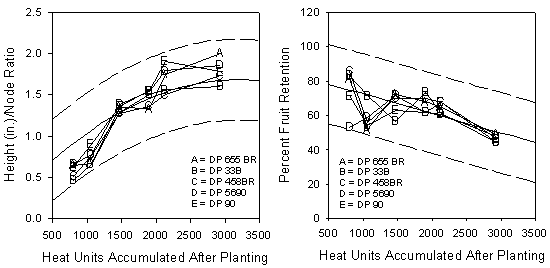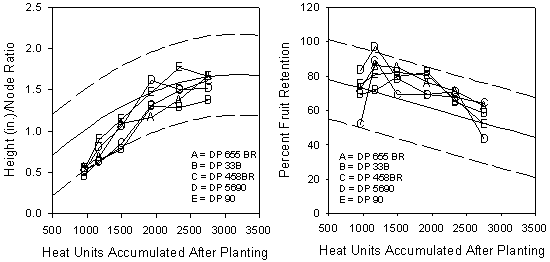Variety performance is an important factor to consider in the production of a cotton crop. This is very true for the 1998 season in Arizona. Accordingly, a careful and thorough evaluation of the varieties on a given farm or in a specific area could be very informative in relation to final yield for this year and variety selection for next year. Factors to consider in reviewing plant condition at this stage of the season would include: final fruit retention (FR), fruiting patterns, overall crop vigor, as well as patterns in crop vigor (patterns in internode distances).
In terms of evaluating patterns in fruiting, one should make note of the following points for variety comparisons and evaluations concerning adaptability, heat tolerance, and/or insect damage:
- node of the first fruiting branch,
- node position of any terminal damage (forking of mainstem) – primarily an environmental factor, can lead to delayed maturity,
- noticeable zones of good FR,
- noticeable zones with poor FR (gaps),
- zones with higher frequencies of parrot-beaked (deformed) bolls,
- zones or patterns associated with the presence of frozen (cavitated) bolls,
- total number of fruiting branches that have harvestable bolls (should be at least ~ 18 – 20),
- signs of any insect damage,
- the total number of bolls per unit area (e.g. bolls/foot of row), and
- percent of unopened bolls.
When trying to identify "zones" or regions of the plant with respect to any of these factors, making use of the number of mainstem nodes above the cotyledonary nodes (cotyledonary node = zero) can serve as a good frame of reference. In Arizona, under non–stressed conditions, plants commonly produce an average of about 2.0 to 2.5 nodes per week during the peak growing season. Therefore, by counting the number of nodes below the terminal one can also estimate dates at which certain zones or nodes on the plant were under development. This can be important in relating periods of crop development to weather events, management (e.g. irrigation or PIX™ applications), or stages of growth such as peak bloom or cut-out.
Farmers and managers commonly express concerns regarding varietal characteristics such as early season vigor and heat tolerance and their impacts on FR, vigor, and yield. This issue seems to have been accentuated with the introduction of many new varieties containing transgenic properties or genes. We are able to conduct direct variety comparisons within many of the experiments that we have around the state. For example, figures 1 and 2 describe the FR and crop vigor (height:node ratios, HNR) patterns associated with a small sub-set of varieties that were measured routinely throughout the 1998 season in tests at Casa Grande and Buckeye in an agronomic evaluation (no Roundup™ applied). Some of the varieties in figures 1 and 2 have been the subject of considerable scrutiny in Arizona and other areas recently. Based on the growth and development data that we have collected at several sites in 1998, we have not detected any inferior agronomic characteristics associated with these new varieties. Final determinations are still pending upon the completion of harvest and the analysis of the yield data from these studies, which will be provided in subsequent reports.
If problems are suspected in terms of variety performance I strongly encourage you to conduct a set of crop evaluations in the field before harvest. For a comparison of varieties, those being grown at the same location would offer the best contrasts. If you are looking for locations where varieties are being tested please contact the Extension Agent in your area for information.
Figure 1. Height to node ratio and percent fruit retention values from Casa Grande, AZ, 1998.
Figure 2. Height to node ratio and percent fruit retention values from Buckeye, AZ, 1998.
Issued in furtherance of Cooperative Extension work, acts of May 8 and June 30, 1914, in cooperation with the U.S. Department of Agriculture, James A. Christenson, Director Cooperative Extension, College of Agriculture and Life Sciences, The University of Arizona.
The University of Arizona is an equal opportunity, affirmative action institution. The University does not discriminate on the basis of race, color, religion, sex, national origin, age, disability, veteran status, or sexual orientation in its programs and activities.
Any products, services, or organizations that are
mentioned, shown, or indirectly implied in this web document do not imply
endorsement by The University of Arizona.
Information provided by Jeffrey C. Silvertooth, silver@ag.arizona.edu
Extension Agronomist - Cotton, College of Agriculture, The University of Arizona.
Material written 10 October 1998.
Home | Cotton | Advisories
document located at: http://cals.arizona.edu/crops/cotton/comments/oct1998cc.html
Copyright © 2001 University of Arizona,
College of Agriculture and Life Sciences
Webmaster: Al Fournier (acis@ag.arizona.edu)

